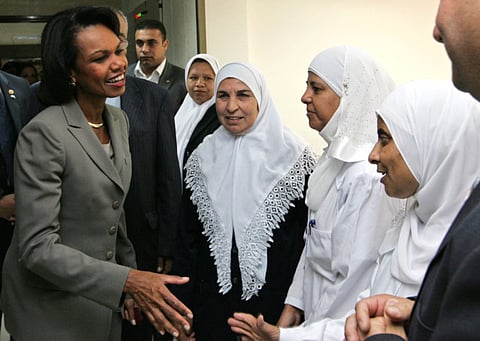The ‘New Middle East’ and its ‘constructive chaos’
Terms originally coined during the Bush administration ring true

Dubai: It was in June, 2006, when the term “New Middle East” was presented to the world by the former US Secretary of State Condoleezza Rice.
During that decade and since, President George W. Bush’s admimistration has been blamed for the instability in the region.
During a joint press conference with the former Israeli Prime Minister Ehud Olmert at the height of the Israeli war on Lebanon in that year, Rice was quoted as saying “a project for a “New Middle East” was being launched from Lebanon.
Rice stated that “what we’re seeing here [Israel war on Lebanon], in a sense, is the growing—the ‘birth pangs’—of a ‘New Middle East’ and whatever we do we [US] have to be certain that we’re pushing forward to the New Middle East [and] not going back to the old one.”
The “New Middle East” project replaced the older and more imposing term, the “Greater Middle East,” which US President George W. Bush earlier had introduced in a G-8 Summit in 2004. Greater Middle East includes other Asian countries that are part of the Moslem world, namely Iran, Turkey, Afghanistan and Pakistan.
“The ‘New Middle East ‘project was introduced publicly by Washington and Tel Aviv with the expectation that Lebanon would be the pressure point for realigning the whole Middle East and thereby unleashing the forces of “constructive chaos,” wrote Mahdi Darius Nazemroaya in Global Research , a Canada-based Center for research on Globalization.
The article headlined “Plans for redrawing the Middle East: The project for a “New Middle East”.
“This “constructive chaos” –which generates conditions of violence and warfare throughout the region– would in turn be used so that the United States, Britain, and Israel could redraw the map of the Middle East in accordance with their geo-strategic needs and objectives” Nazemroaya added.
After the Israeli war on Lebanon and the ousting of the former Iraqi president Saddam Hussein, the two terms of “New Middle East” and “Greater Middle East” surfaced, as well as the “creative chaos” term.
Some ordinary Arabs and anaylsts relate the “creative chaos” and the “Arab Spring”, which is sweeping many Arab countries, with the New Middle East term or the “Greater Middle East” term.
“When one regime was ousted, (Iraqi regime), anaylsts (kept) repeated the term of “New Middle East”,” wrote Abdel Rahman Al Rashid, Editor-in-Chief of the pan-Arab Al Sharq Al Awsat newspaper in an article published in January 2012.
“Now we are without Hosni Mubarak’s regime (Egypt), with Muamer Qaddafi’ regime (Libya) and Zein Al Abideen Bin Ali (Tunisia)…. Regimes that are ruling more than 100 million Arabs have had disappeared, and the Middle East map became full with holes waiting for it to be filled how and by who. The winds are still moving the region’s sands,” he said.
Sign up for the Daily Briefing
Get the latest news and updates straight to your inbox



